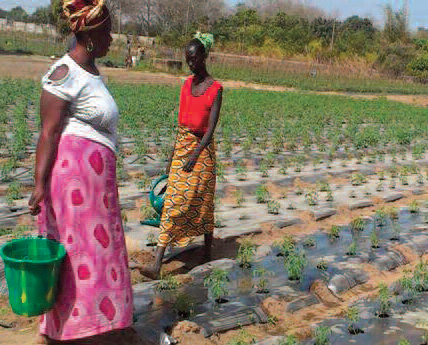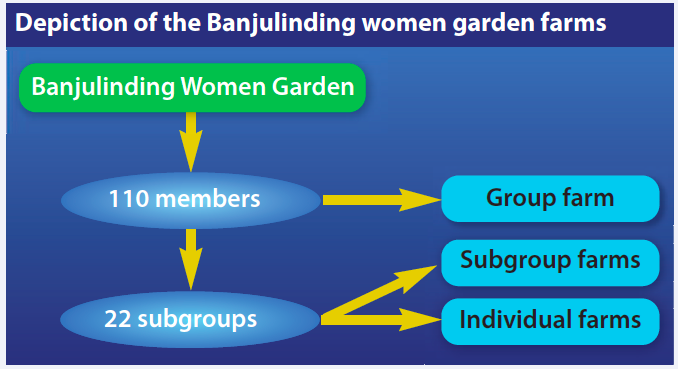Women’s gardening in The Gambia
 Olawale F. Olaniyan
Olawale F. Olaniyan
Olawale F. Olaniyan is a (volunteer) researcher with the International Trypanotolerance Centre and has over seven years of experience in agricultural research for development.
Background
The community farming association, which eventually transformed to Banjulinding Women’s Garden, started in 1989 with one hectare piece of land and an association of 80 members who collectively cultivated either maize or millet during the three to four month cropping season. In 1996, with external support, including technical advice and fencing of an eight-hectare land area, the association was facilitated to plant watermelon and peanuts. A year later, support was provided for additional seedlings, fertilizers and watering cans, storage space and offices, resulting in a wider variety of vegetables planted (including tomato, peppers and egg plants as well as leguminous crops such as peanuts) and an increased production of 120.8 metric tons of produce. The women’s families consumed the produce and extra were sold in the surrounding vegetable markets.
 Over a period of more than 15 years, the garden and the association has grown. There are now 110 women organized into 22 subgroups of five women each. Each subgroup jointly cultivates crops such as groundnut, pepper, tomato, green beans, okra, eggplant, cucumber, and sweet potato on three different plots, each measuring 40m x 30m. Each member is also entitled to a personal plot. The association’s farm, now measuring 23 hectares in total, can yield up to 2,000kg of maize and 1,000 kg of groundnuts. To diversify the nutritional base and sources of income, the association invested in cattle and rabbits. Milk is collected and sold on a daily basis to the members as an important source of animal protein.
Over a period of more than 15 years, the garden and the association has grown. There are now 110 women organized into 22 subgroups of five women each. Each subgroup jointly cultivates crops such as groundnut, pepper, tomato, green beans, okra, eggplant, cucumber, and sweet potato on three different plots, each measuring 40m x 30m. Each member is also entitled to a personal plot. The association’s farm, now measuring 23 hectares in total, can yield up to 2,000kg of maize and 1,000 kg of groundnuts. To diversify the nutritional base and sources of income, the association invested in cattle and rabbits. Milk is collected and sold on a daily basis to the members as an important source of animal protein.
Achievements:
- Increased food production. Average annual tomato yield from a subgroup’s plot is 4,000 kg in addition to the 10kg/week that is shared by five women for home consumption. From 2005 to 2013, the association increased crop yield by 50%.
- Improved food security and income. An irrigation system allows for year-round farming which has increased member’s availability and access to a variety of produce and a source of income even during the annual hungry season (June to August). Income generated through the sale of farm produce has supported a more diverse diet, the payment of school fees and other family needs.
- Flexible, baby-friendly employment. Farming activities are flexible and women and their child care needs are met through group support. Pregnant women in the last trimester and nursing mothers are relieved of any farming activity by the other group members. A section of the garden is demarcated for infants where they are taken care of by adult family members. Additionally, all women benefit from a three-hour break each day allowing them to be directly involved in food preparation and feeding their families.

Moving forward
Although there have been breaks with the association’s longterm donor, the group has been sustained based on savings and the effective coordination and corporation of its members. However, three key challenges remain: 1) fluctuations in market prices (particularly in the rainy season), 2) lack of storage facilities and 3) poor fencing structures. While these currently limit the Banjulinding Women’s Garden, renovations are planned and, once realized, will ensure greater storage and an expansion in processing in the near future.
Conclusion:
The Banjulinding Women Garden is an example of how a committed group of women can be empowered and organized to contribute to their family’s food and nutrition security and the wider agricultural system.

